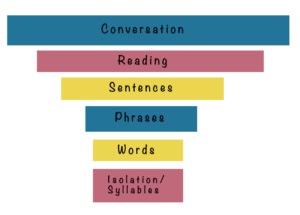A Speech-Language Pathologist’s Secret to Accent Training
A Speech-Language Pathologist’s Secret to Accent Training
Speech-Language Pathologists, or SLPs, are most known for assessing and treating speech and language disorders. SLPs help individuals with speech, spoken language, written language, swallowing, and cognitive difficulties. Our best-kept secret is that SLPs provide accent training.
There are many professionals out there who work on accent training but one of the unique skills SLPs can offer is our specialized training in speech sound production. I’ve heard many well-meaning non-SLP professionals try to explain the characteristics of speech sounds and how to produce them. However, a lot of explanations are downright wrong and cringe-worthy.
SLPs have been trained to assess speech sound production, teach the production of target sounds, and help individuals generalize sound production from isolation all the way to conversation. These techniques can help someone learn an Irish accent, learn a German accent, or learn any accent! Here is more about that:
Assessment of Articulators
Speech sounds are produced using our articulators. These include:
Lips
Teeth
Tongue
Jaw
Alveolar ridge- gum ridge behind top teeth
Palate- the roof of the mouth
Larynx- the voice box
Nose
Pharynx- throat
An SLP can complete what is called an oral mechanism examination (“oral mech exam” or “oral periph” for short) to assess the structural and functional integrity of these articulators for speech production. If the SLP discovers that an issue with any of the articulators is impacting speech, they can make an appropriate referral for further consult.

Assessment of Speech Sounds

Speech sounds can be divided up into consonants and vowels. Everyone is familiar with the English alphabet: 26 letters; 21 consonants and 5 vowels (a, e, i, o u). However, when it comes to speech sound production and accent training, you must think about how a word sounds, not how it is spelled.
In Standard American English (SAE), we have 24 consonant sounds. Consonants are categorized by place, manner, and voicing.
Place
refers to the articulators that work together to produce a sound. For example, /p, b/ are considered bilabials meaning they are produced using your top and bottom lip. The sounds /f, v/ are considered labiodental meaning they are produced using your bottom lip and top teeth.
Manner
refers to how the air flows through the articulators. For example, /p, b/ are considered ‘stops’, meaning that airflow is completely blocked by the lips, and /f, v/ are considered ‘fricatives’, meaning that airflow is partially blocked by the lower lip and upper teeth.
Voicing
refers to the activity in the vocal folds in the voice box. When the vocal folds are apart and not vibrating, the sound is voiceless (p, f). When the vocal folds are together and vibrating, the sound is voiced (b,v).
There are approximately 3x more the number of vowels in SAE compared to other languages. Because of this, our regional dialects in the U.S. are easily distinguished by vowel production. For example, the two words ‘pen’ and ‘pin, in the northern U.S., are pronounced differently but in the southern US, they are pronounced the same. All vowels are voiced and have 3 distinctive features: jaw height, tongue position, and lip roundedness.
SLPs have been trained to think in sounds, not letters or words, and to hear minute differences in speech sound production. We can easily listen to a person in conversation and hear consonant and vowel errors, or differences, that need to be addressed to improve the intelligibility and naturalness of spoken English. A layperson can hear these differences in someone with an accent but are not able to describe them.

Production of Sounds
Once target consonants and vowels have been established, the SLP has many tips and tricks, called elicitation techniques, to help an individual produce target sounds across all contexts. Typically, a sound is first introduced in isolation to get a feel for correct tongue placement and airflow, then quickly moved up the spoken hierarchy:
Isolation – Syllables – Words – Phrases – Sentences – Reading – Conversation
Individuals may struggle in any of these context areas and need guidance on how to self-correct. An SLPs trained ear can quickly hear this breakdown and offer cues to get back on track quickly.
An SLP will also help an individual train his/her own ear for sound production so they can hear their own productions and errors. A common technique for this is to have the individual say a word or word correctly and then incorrectly so they can hear and feel the difference in sound production. This is called building “phonological awareness” and will help one make progress more rapidly.

Naturalness
The two main goals of accent training are to improve intelligibility and naturalness in conversation. Individuals will reach these goals through different avenues but an SLP can use his/her knowledge of speech sounds to incorporate target sounds into more conversational practice while addressing other areas like rate of speech, intonation, and syllable stress. An SLP can also easily determine if an individual’s difficulty with a speech sound is due to an accent or a true speech sound disorder. If there is a true speech sound disorder, an SLP can target that directly in addition to the other areas. It’s a lot to think about! That’s why you need an SLP trained ear 🙂
For accent training ideas, check out my blog Using Alexa in Accent Modification.
References
American Speech-Language-Hearing Association. (n.d.). Accent modification [Practice portal]. Retrieved month day, year, from www.asha.org/Practice-Portal/Professional-Issues/Accent-Modification/
McKinney, Robert (2019). Here’s How to Do Accent Modification: A Manual for Speech-Language Pathologists 1st Edition. Plural Publishing.

One Comment